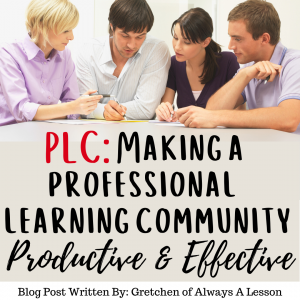PLC: Making A Professional Learning Community Productive & Effective
 The acronym PLC refers to Professional Learning Communities, which are organized collaborative structures among educators. Many schools have PLC’s, but how they are set up and run vary greatly.
The acronym PLC refers to Professional Learning Communities, which are organized collaborative structures among educators. Many schools have PLC’s, but how they are set up and run vary greatly.
A discussion recently came up in the Instructional Coaching Connection Facebook group where a coach was looking for advice from other coaches on how PLC’s are ran at their school sites. She was feeling that the current set up in her building was ineffective and wanted input on how to make improvements.
This blog post is an effort to answer those same concerns that other teacher leaders might be experiencing about what constitutes “effective” PLC practices.
The Purpose of a PLC
As stated earlier, a PLC is a structure and support schools put in place for teachers to collaborate with each other on their instruction. It operates as a professional think tank where educators can calibrate instructional pacing and content topics among their peers while also problem solving current obstacles.
However, how schools set up their PLC’s vary greatly. Some schools use this time for teachers to plan lessons together, others use it to dive into assessment data to make plans of action for student support, while some use it for everything else in between. The varying uses of a PLC is what leaves teachers and administrators frustrated. Unclear expectations and lack of results hinder productivity and effectiveness.
The Structure of a PLC
-
- Need a PLC guide to help structure and run meetings? Grab the Meeting Minutes Guide or the Data Chat Guide or snag the PLC & Data Bundle!
The Benefit of a PLC
-
- Hear what other teachers are doing in their classroom
- Gain new ideas for ways to reach students more effectively
- Receive support in areas of weakness
- Develop a short and long term game plan for instruction
- Hone in on what is happening in the classroom and why
- Locate student achievement trends among grade levels or content areas
- Build camaraderie and relationships among peers
We must protect our teacher talent by supporting the development of their creativity and skill. A PLC can do just that, if implemented with intention.
If you are need of resources to help you become an even stronger coach, browse these printable and digital options. Check out my instructional coaching must-haves here. Catch up on my latest blog posts here.
How does your school implement a PLC?

